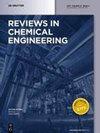Membrane-aerated biofilm reactor (MABR): recent advances and challenges
IF 6.6
3区 工程技术
Q1 ENGINEERING, CHEMICAL
引用次数: 0
Abstract
Abstract Membrane-aerated biofilm reactor (MABR) has been considered as an innovative technology to solve aeration issues in conventional bioreactors. MABR uses a membrane to supply oxygen to biofilm grown on the membrane surface. MABR can perform bubbleless aeration with high oxygen transfer rates, which can reduce energy requirements and expenses. In addition, a unique feature of counter-diffusion creates a stratified biofilm structure, allowing the simultaneous nitrification–denitrification process to take place in a single MABR. Controlling the biofilm is crucial in MABR operation, since its thickness significantly affects MABR performance. Several approaches have been proposed to control biofilm growth, such as increasing shear stress, adding chemical agents (e.g., surfactant), using biological predators to suppress microorganism growth, and introducing ultrasound cavitation to detach biofilm. Several studies also showed the important role of membrane properties and configuration in biofilm development. In addition, MABR demonstrates high removal rates of pollutants in various wastewater treatments, including in full-scale plants. This review presents the basic principles of MABR and the effect of operational conditions on its performance. Biofilm formation, methods to control its thickness, and membrane materials are also discussed. In addition, MABR performance in various applications, full-scale MBRs, and challenges is summarized.曝气膜生物膜反应器(MABR):最新进展与挑战
膜曝气生物膜反应器(MABR)被认为是解决传统生物反应器曝气问题的一种创新技术。MABR利用膜为生长在膜表面的生物膜提供氧气。MABR可以进行无气泡曝气,具有高氧传输速率,可以降低能源需求和费用。此外,反扩散的独特功能创造了分层的生物膜结构,允许在单个MABR中同时进行硝化-反硝化过程。生物膜的控制是MABR操作的关键,因为生物膜的厚度对MABR的性能有很大的影响。人们提出了几种控制生物膜生长的方法,如增加剪切应力,添加化学剂(如表面活性剂),使用生物捕食者抑制微生物生长,以及引入超声空化分离生物膜。一些研究也显示了膜的性质和结构在生物膜发育中的重要作用。此外,MABR在各种废水处理中显示出很高的污染物去除率,包括在大型工厂中。本文综述了MABR的基本原理以及操作条件对其性能的影响。讨论了生物膜的形成、控制生物膜厚度的方法和膜材料。此外,还总结了MABR在各种应用中的性能、全尺寸mbr以及面临的挑战。
本文章由计算机程序翻译,如有差异,请以英文原文为准。
求助全文
约1分钟内获得全文
求助全文
来源期刊

Reviews in Chemical Engineering
工程技术-工程:化工
CiteScore
12.30
自引率
0.00%
发文量
37
审稿时长
6 months
期刊介绍:
Reviews in Chemical Engineering publishes authoritative review articles on all aspects of the broad field of chemical engineering and applied chemistry. Its aim is to develop new insights and understanding and to promote interest and research activity in chemical engineering, as well as the application of new developments in these areas. The bimonthly journal publishes peer-reviewed articles by leading chemical engineers, applied scientists and mathematicians. The broad interest today in solutions through chemistry to some of the world’s most challenging problems ensures that Reviews in Chemical Engineering will play a significant role in the growth of the field as a whole.
 求助内容:
求助内容: 应助结果提醒方式:
应助结果提醒方式:


